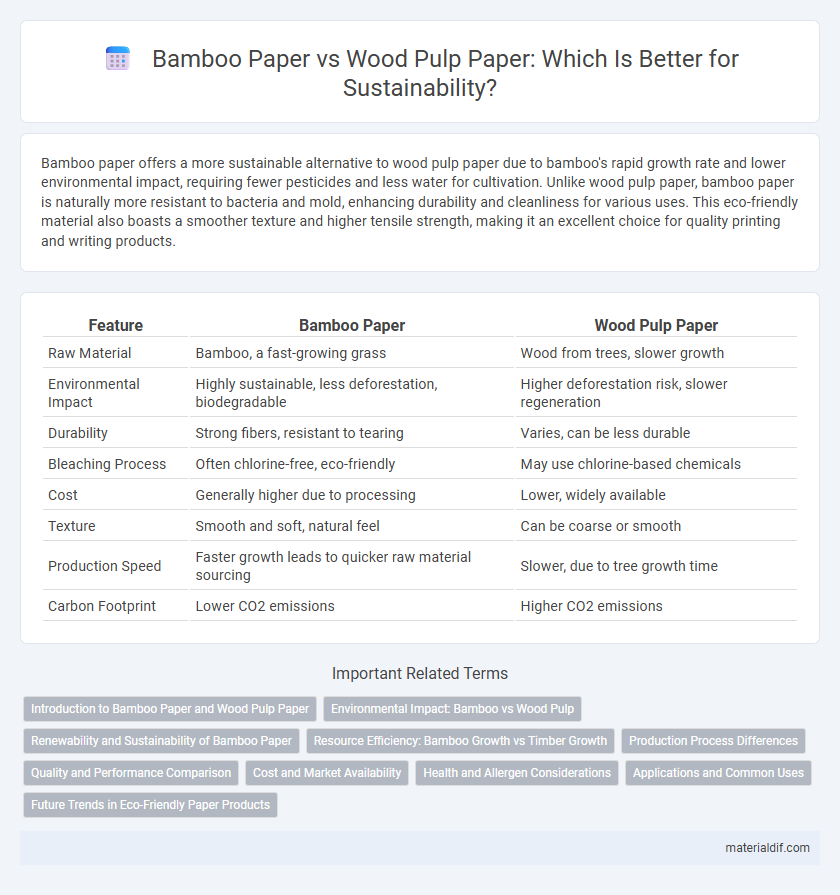Bamboo paper offers a more sustainable alternative to wood pulp paper due to bamboo's rapid growth rate and lower environmental impact, requiring fewer pesticides and less water for cultivation. Unlike wood pulp paper, bamboo paper is naturally more resistant to bacteria and mold, enhancing durability and cleanliness for various uses. This eco-friendly material also boasts a smoother texture and higher tensile strength, making it an excellent choice for quality printing and writing products.
Table of Comparison
| Feature | Bamboo Paper | Wood Pulp Paper |
|---|---|---|
| Raw Material | Bamboo, a fast-growing grass | Wood from trees, slower growth |
| Environmental Impact | Highly sustainable, less deforestation, biodegradable | Higher deforestation risk, slower regeneration |
| Durability | Strong fibers, resistant to tearing | Varies, can be less durable |
| Bleaching Process | Often chlorine-free, eco-friendly | May use chlorine-based chemicals |
| Cost | Generally higher due to processing | Lower, widely available |
| Texture | Smooth and soft, natural feel | Can be coarse or smooth |
| Production Speed | Faster growth leads to quicker raw material sourcing | Slower, due to tree growth time |
| Carbon Footprint | Lower CO2 emissions | Higher CO2 emissions |
Introduction to Bamboo Paper and Wood Pulp Paper
Bamboo paper is derived from the fast-growing bamboo plant, offering a sustainable alternative due to its renewable nature and higher yield per acre compared to traditional wood pulp sources. Wood pulp paper originates from trees that require decades to mature, leading to significant deforestation and environmental impact. Bamboo paper typically exhibits greater durability, natural antibacterial properties, and a smaller carbon footprint than conventional wood pulp paper.
Environmental Impact: Bamboo vs Wood Pulp
Bamboo paper significantly reduces environmental impact compared to wood pulp paper due to bamboo's rapid growth cycle and minimal need for pesticides or fertilizers. Bamboo cultivation requires less water and helps preserve forests by decreasing the demand for deforestation associated with traditional wood pulp paper. The biodegradability and lower carbon footprint of bamboo paper further contribute to its status as an eco-friendly alternative to conventional wood pulp products.
Renewability and Sustainability of Bamboo Paper
Bamboo paper offers superior renewability compared to traditional wood pulp paper due to bamboo's rapid growth cycle, allowing it to be harvested sustainably every 3-5 years without causing deforestation. Its ability to regenerate quickly minimizes environmental impact, promoting sustainable forestry practices and reducing carbon footprint. Bamboo's natural resistance to pests and diseases also eliminates the need for harmful chemicals, enhancing its sustainability profile over wood pulp alternatives.
Resource Efficiency: Bamboo Growth vs Timber Growth
Bamboo paper significantly outperforms wood pulp paper in resource efficiency due to bamboo's rapid growth rate, reaching maturity in 3 to 5 years compared to timber's 20 to 50 years. This accelerated growth cycle allows for more frequent harvesting and sustainable yield without depleting natural forests. Bamboo's ability to regenerate from its root system also eliminates the need for replanting, reducing soil erosion and resource consumption associated with timber forestry.
Production Process Differences
Bamboo paper production involves harvesting fast-growing bamboo stalks, which are mechanically crushed and chemically processed to extract fibers with fewer chemicals compared to wood pulp paper, reducing environmental impact. The wood pulp paper production process relies on cutting trees followed by intensive chemical pulping methods like kraft or sulfite processes, which involve higher energy consumption and harsh chemical usage. Bamboo's natural antibacterial properties and rapid renewability contribute to a more sustainable and eco-friendly paper manufacturing process compared to traditional wood pulp methods.
Quality and Performance Comparison
Bamboo paper demonstrates higher durability and tear resistance compared to traditional wood pulp paper due to its longer and stronger fiber structure. It also offers superior absorbency and faster drying times, enhancing print clarity and reducing smudging in various printing applications. The naturally antimicrobial properties of bamboo fibers contribute to improved hygiene and longevity, making bamboo paper a high-performance alternative in both office and industrial settings.
Cost and Market Availability
Bamboo paper generally costs more than wood pulp paper due to its sustainable harvesting and processing methods, which require specialized equipment and longer growth cycles. Market availability of bamboo paper is increasing but remains limited compared to the widespread distribution and mass production of wood pulp paper. Businesses seeking eco-friendly alternatives often balance the higher price and lower availability of bamboo paper against the environmental benefits it offers.
Health and Allergen Considerations
Bamboo paper is naturally hypoallergenic and resistant to dust mites, making it an excellent choice for individuals with allergies or sensitive skin. In contrast, traditional wood pulp paper often contains chemical additives and bleaching agents that can trigger allergic reactions or respiratory issues. Bamboo paper's antimicrobial properties also reduce the risk of bacterial growth, promoting a healthier environment for everyday use.
Applications and Common Uses
Bamboo paper is widely used in eco-friendly packaging, notebooks, and specialty art papers due to its natural durability and smooth texture. Wood pulp paper remains dominant in mass-market printing, office supplies, and newspapers, offering versatility and cost-effectiveness. Bamboo paper's rapid renewability makes it ideal for sustainable products, while wood pulp paper suits high-volume commercial printing needs.
Future Trends in Eco-Friendly Paper Products
Bamboo paper is emerging as a sustainable alternative to traditional wood pulp paper due to its rapid growth cycle and lower environmental impact, making it a key player in future eco-friendly paper products. Innovations in bamboo fiber processing are enhancing paper durability and texture, appealing to consumers seeking green solutions. Market trends indicate increasing adoption of bamboo paper in packaging, printing, and stationery as industries prioritize renewable resources and carbon footprint reduction.
Bamboo paper vs wood pulp paper Infographic

 materialdif.com
materialdif.com